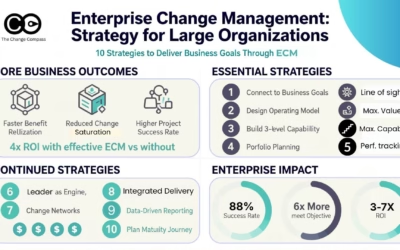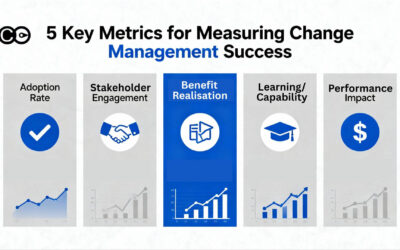Transformation and change professionals often find themselves in the position of defending the value of change management. Despite the critical role that change management plays in ensuring successful project outcomes, many stakeholders remain sceptical. Some view it as a discretionary cost rather than an essential function. Many change management centres of excellences have faced the axe or at least been downsized.
This scepticism can be exacerbated by comments that dismisses roles such as change managers as unnecessary. In Australia, there are even comments by a politician that positions such as change manager “do nothing to improve the lives of everyday Australians”. The context of this comment was targeting positions related cultural, diversity and inclusions advisors, along the same lines as that driven by Trump in the United States. This has upset a lot of change professionals as you can imagine.
To counter this, Change Management Centres of Excellence (CoEs) must move beyond advocacy and education to proactively demonstrate their tangible value. Let’s explore practical approaches to proving the value of change management, ensuring its sustained recognition and investment.
1. Leverage Empirical Research to Support Your Case
There is substantial research demonstrating that change management interventions lead to improved project outcomes. Change practitioners can use these studies as evidence to substantiate their value. For example:
Prosci Research has consistently shown that projects with excellent change management are significantly more likely to achieve their objectives compared to those with poor change management. According to the Best Practices in Change Management study, 88% of participants with excellent change management met or exceeded objectives, while only 13% of those with poor change management met or exceeded objectives. This means that projects with excellent change management were approximately seven times more likely to meet objectives than those with poor change management (Source).
Even implementing fair change management practices can lead to a threefold improvement in project outcomes (Source).
McKinsey found that transformation initiatives are 5.8 times more successful if CEOs communicate a compelling change story, and 6.3 times more successful when leaders share messages about change efforts with the rest of the organisation (Source).
By framing change management as an evidence-based discipline, Change CoEs can strengthen their credibility and influence senior stakeholders. Furthermore, sharing industry benchmarks and case studies showcasing successful change management implementations can add weight to the argument.
2. Calculate the Financial Value of Managing a Change Portfolio
Executives prioritize financial metrics, making it essential to quantify the financial impact of change management. This article How to calculate the financial value of managing a change portfolio provides a structured approach to calculating the financial value of managing a change portfolio. Some key financial considerations include:
- Productivity Gains: Effective change management reduces employee resistance and increases adoption rates, leading to quicker realization of benefits. For instance, if a new system is introduced, strong change management ensures employees use it efficiently, eliminating productivity dips.
- Cost Avoidance: Poorly managed change efforts can lead to rework, delays, and even project failures, incurring significant costs. For example, a failed system implementation due to lack of change management could require millions in additional investments to correct issues and retrain employees.
- Revenue Acceleration: When changes are adopted swiftly and efficiently, organisations can capitalize on new opportunities faster. In industries such as retail, banking, and technology, time-to-market is critical. The faster employees and customers adapt to new changes, the sooner the organisation can generate revenue from those changes.
- Risk Mitigation: Resistance and poor change adoption can lead to compliance risks, reputational damage, and disengagement, all of which have financial implications. A compliance failure due to lack of engagement in a new regulatory process could lead to fines and reputational loss.
To make this more tangible, Change CoEs should create financial models that quantify the cost of failed change initiatives versus successful ones. They can also track and report savings from avoided risks and improved efficiency, linking these directly to the organisation’s bottom line.
3. Demonstrate Value Through Behaviour Change
One of the most effective ways to prove the impact of change management is by tracking behaviour change. Change is not successful unless employees adopt new ways of working, and this can be measured using:
- Adoption Metrics: Track usage rates of new systems, tools, or processes. For instance, if a company implements a new CRM system, measuring login frequency, data entry consistency, and feature utilization can indicate successful adoption.
- Performance Data: Compare key performance indicators (KPIs) before and after change implementation. If a new customer service protocol is introduced, tracking customer satisfaction scores and response times will provide tangible insights into its effectiveness.
- Employee Surveys: Gauge sentiment and readiness for change. Pulse surveys can reveal how confident employees feel about a transformation and whether they understand its purpose and benefits.
- Stakeholder Feedback: Capture qualitative insights from leaders and frontline employees. Executives often rely on direct feedback from managers to gauge whether changes are being embraced or resisted.
By presenting a clear narrative that links change management efforts to observable behaviour shifts, Change CoEs can make their value more tangible. It is also beneficial to conduct longitudinal studies, tracking behaviour change over time to ensure sustained impact.
Imagine being able to present a set of behaviour metrics that are forward looking measures for benefit realisation. This can position favourably the tangible value of change management activities and approaches.

4. Use Non-ROI Methods to Articulate Value
While financial metrics are important, relying solely on traditional ROI calculations can be limiting. There are several alternative methods in the article Why using change management ROI calculations severely limits its value:
- Customer Experience Improvements: Measure customer satisfaction before and after change initiatives. If a change initiative improves customer interactions, metrics such as Net Promoter Score (NPS) and retention rates will reflect its impact.
- Employee Engagement and Retention: Effective change management reduces uncertainty and anxiety, leading to better engagement and lower attrition. Organisations that manage change well see lower absenteeism and stronger workforce commitment.
- Organisational Agility: Organisations with strong change management capabilities adapt faster to market disruptions. Companies that successfully embed change management in their DNA are more resilient during economic downturns or competitive shifts.
- Cultural Transformation: Change management plays a key role in shaping corporate culture, which influences long-term business success. For example, embedding a culture of continuous learning can make future change initiatives easier to implement.
By framing change management as a driver of strategic outcomes, rather than just an operational function, Change CoEs can enhance their perceived value.
5. Position change as a key part of risk management
Demonstrating the value of change management through risk management is a powerful approach for the Change CoE. By highlighting how effective change management mitigates various risks associated with organisational change, you can justify its importance and secure necessary support and resources.
This is particularly useful and important for the financial services sector where risk is now the front and centre of attention for most senior leaders, with the increasingly intense regulatory environment and scrutiny by regulators.
Risk in Change
Change initiatives inherently carry risks that can impact an organisation’s operations, culture, and bottom line. Effective change management helps identify and address these risks proactively. By implementing a robust change risk management framework, organisations can adapt their overall risk management strategies to cover change-related risks throughout the project lifecycle. This approach allows for early identification of potential obstacles, enabling timely interventions and increasing the likelihood of successful change implementation.
Delivery Risk
Change management plays a crucial role in mitigating delivery risks associated with project implementation. While project managers typically focus on schedule, cost, and quality risks, change managers can identify and manage risks that are delivered into the business as a result of the change. By working closely with project managers, change professionals can introduce processes to minimize the potential business impact of these delivered risks during project delivery. This collaboration ensures that the project not only delivers the required change but does so with minimal disruption to the organisation.
Quantifying Risk Mitigation
To further demonstrate the value of change management, it’s essential to quantify its contribution to risk mitigation. By adapting the organisation’s risk assessment matrix or tools, change managers can determine the probability and potential impact of each identified risk. This analysis allows for prioritization of risks and implementation of appropriate mitigation strategies.
By tracking how change management interventions reduce the likelihood or impact of these risks, you can provide tangible evidence of its value to senior leadership. By framing change management as a critical component of risk management, you can shift the conversation from justifying its existence to showcasing its indispensable role in ensuring successful organisational transformations. This not only demonstrates the value of change management but also aligns it with broader organisational goals of risk reduction and strategic success.

6. Proactively Measure and Track Value Delivery
Tracking and reporting the tangible value created by change management is essential. Organisations frequently undergo leadership transitions, and new decision-makers may question the need for a Change CoE. A well-documented history of impact ensures continuity and ongoing investment.
McKinsey research indicated that Transformations that provide both initiative-level and program-level views of progress through relevant metrics are 7.3 times more likely to succeed (Source).
To achieve this:
- Develop a Change Management Dashboard: Use KPIs to track adoption rates, employee readiness, and impact on business metrics.
- Create Case Studies: Document success stories with before-and-after comparisons. Case studies should include challenges, change management interventions, and final outcomes.
- Conduct Quarterly Impact Reviews: Regularly present insights to senior leaders. Demonstrating trends and ongoing improvements ensures continued executive buy-in.
- Link Change Efforts to Strategic Priorities: Show how change management enables key business goals, such as revenue growth, market expansion, or operational efficiency.
7. Shift from Education to Results-Driven Influence
While stakeholder education is important, it has limitations. Many executives have preconceived notions about change management. Rather than relying solely on relationship-building, focus on delivering results that speak for themselves. Key strategies include:
- Pilot Programs: Run small-scale change initiatives with measurable impact. If an executive is sceptical, a successful pilot can turn them into an advocate. It is highly unlikely that executives will not want to see metrics that indicate how effective a change initiative is progressing.
- Strategic Partnerships: Align with key business units to co-own change success. Partnering with Finance, HR, Risk, Operations and IT leaders can reinforce the business value of change management.
- Agile Change Management: Deliver incremental wins to showcase immediate value. Iterative, feedback-driven approaches ensure continuous improvement and visibility.
Change management professionals must move beyond justification and actively prove their worth. By leveraging empirical research, financial calculations, behaviour tracking, alternative value measures, and proactive reporting, Change CoEs can secure their place as indispensable business functions. In a world where scepticism towards roles like change management persists, the best defence is a compelling, evidence-based demonstration of impact.






